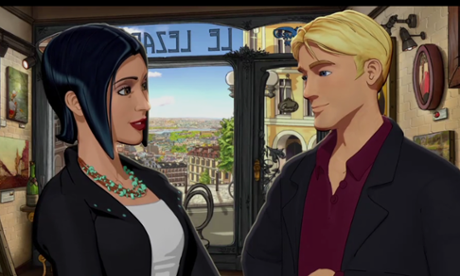
Revolution Software / PC, PSN, iOS, Android / £4.99 (smartphone), £18.99 (Steam, complete edition)
There’s a moment towards the end of The Serpent’s Curse when the game confronts you with a stark choice. A villain is jabbing a pistol in protagonist George Stobbart’s ribcage and demanding he solve the riddle of a powerful artefact’s whereabouts. You know it’s in George’s large pockets. Time for truth or bluff: what’s it gonna be?
This being Broken Sword, it makes no difference. Both options end with somebody shot, the artefact stolen and George imprisoned. If you know the series, none of this is a spoiler. Nothing you did in episode one will change what happens here one iota and every action you take subsequently follows the same pattern. The presentation of choice in Telltale titles may be so much smoke and mirrors, but Revolution Software barely bothers with the illusion. Fans will love this homage to old school adventure games, but the failure to fix ancient problems with the genre will inevitably restrict its appeal.
Still, it ups the ante considerably from episode one. Whereas the plot and puzzles previously felt a little tame, this sets off at a cracking pace which is mostly maintained until its satisfyingly bonkers conclusion. We left our heroes George and Nico trapped atop a burning building in London and, while surprisingly there’s no puzzle to solve this, the action quickly moves to a Catalonian villa complete with a crazy man shooting indiscriminately. Adding to the sense of peril is the swift reappearance of George’s nemesis: the goat (to the uninitiated, think Sideshow Bob and rakes).
Besting the goat and bullets requires some lateral thinking before you get to explore the house and tackle some more meaty puzzles, and there’s a much better balance of physical challenges and code-breaking this time around. Some of the latter puzzles stumped me so badly I had to dip into the excellent tips tool for help, but they’re never illogical. The backgrounds remain so delightfully drawn you won’t mind gazing while you concoct a solution anyway, although the continued absence of hotspot-highlighting means you will have to comb them on occasions. I got stuck during the finale owing to my failure to find the vital crack in the wall.
Slow but sure
This sequence also flags-up the perennially sluggish character movement, with Nico seemingly tiptoeing towards saving the world. Animation is improved and I noticed fewer bugs, but the requirement to move to a precise spot for dialogue is a recurring irritation. Thankfully, the writing justifies the wait. There are better jokes, better delivered, with a particularly wry take on the genre’s quirks. One scene sees Nico, hanging from a cable car, mention Chelsea football club to disprove a goon’s theory of determinism and prevent him killing you. Jose Mourinho himself would appreciate those dark arts. Nico’s vocal performance also flourishes after a slight hesitancy in episode one. The interplay between her and George is better than ever, a beautifully judged mix of eye-rolling, sarcasm and sexual tension, ably assisted by having to insist to every oddball they meet that they’re not an item.
These oddballs, including some old friends, do a fine job of fleshing out the epic narrative. After the murder mystery of episode one, this marks a welcome return to the series’ mystic roots. Guided by Gnostics, you must ultimately venture to the Garden of Eden and prevent Lucifer destroying Jehovah, because balance. The only letdown is the cast of human foes, with the big bad’s motivations for plunging the world into chaos merely hinted at. He also might as well ape Dr Evil in shouting "begin the unnecessarily slow-moving dipping mechanism" given the way he inexplicably lets you live right before swanning off and leaving you to your fate.
In such ways, Broken Sword is a fine tribute to old fashioned storytelling, as well as the adventure genre itself. It’s fun to poke fun at such tropes, but if the developers had improved them too this could have marked a breakout game. As it stands, while highly enjoyable, it’s strictly for fans. Hopefully they waited for both parts to be available: the decision to split it remains pig-headed and it undoubtedly works best as a coherent whole. Still, if you played and enjoyed part one, this is an admirable conclusion to a loveable series.
• Broken Sword: The Serpent's Curse, Part One – review
• Broken Sword 5: The Serpent's Curse announced as Kickstarter project

